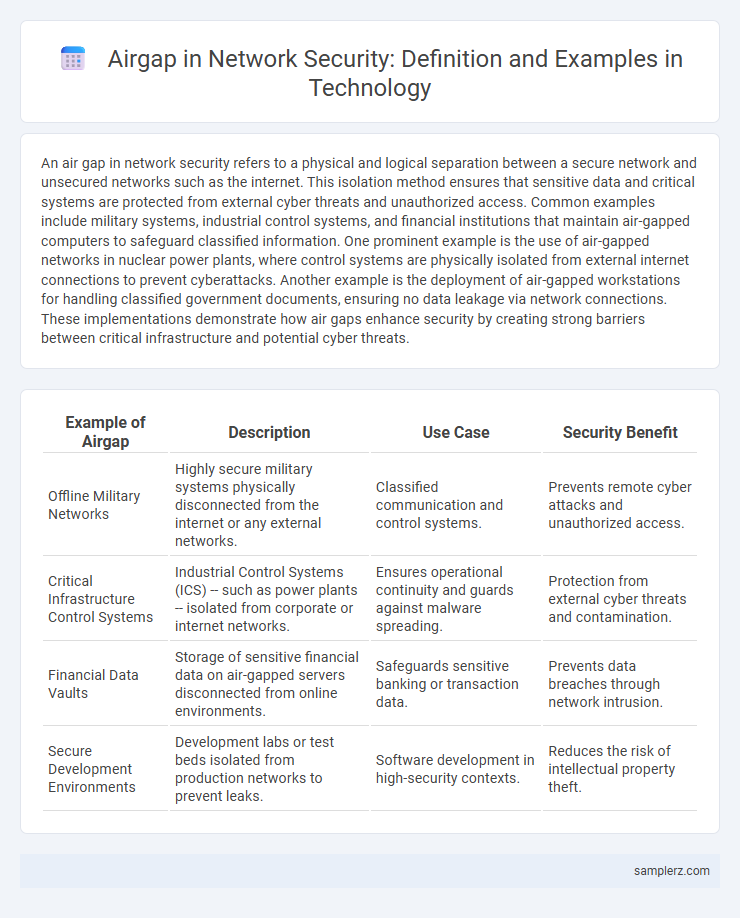An air gap in network security refers to a physical and logical separation between a secure network and unsecured networks such as the internet. This isolation method ensures that sensitive data and critical systems are protected from external cyber threats and unauthorized access. Common examples include military systems, industrial control systems, and financial institutions that maintain air-gapped computers to safeguard classified information. One prominent example is the use of air-gapped networks in nuclear power plants, where control systems are physically isolated from external internet connections to prevent cyberattacks. Another example is the deployment of air-gapped workstations for handling classified government documents, ensuring no data leakage via network connections. These implementations demonstrate how air gaps enhance security by creating strong barriers between critical infrastructure and potential cyber threats.
Table of Comparison
| Example of Airgap | Description | Use Case | Security Benefit |
|---|---|---|---|
| Offline Military Networks | Highly secure military systems physically disconnected from the internet or any external networks. | Classified communication and control systems. | Prevents remote cyber attacks and unauthorized access. |
| Critical Infrastructure Control Systems | Industrial Control Systems (ICS) -- such as power plants -- isolated from corporate or internet networks. | Ensures operational continuity and guards against malware spreading. | Protection from external cyber threats and contamination. |
| Financial Data Vaults | Storage of sensitive financial data on air-gapped servers disconnected from online environments. | Safeguards sensitive banking or transaction data. | Prevents data breaches through network intrusion. |
| Secure Development Environments | Development labs or test beds isolated from production networks to prevent leaks. | Software development in high-security contexts. | Reduces the risk of intellectual property theft. |
Understanding Airgaps in Network Security
Airgaps in network security involve physically isolating a computer or network from unsecured networks, such as the internet, to prevent unauthorized access or cyberattacks. This method is widely used in critical infrastructure like military systems, industrial control systems, and financial institutions, where safeguarding sensitive data is essential. Airgapped networks rely on manual data transfer methods, such as USB drives or secure physical carriers, ensuring a robust protection layer against remote hacking attempts.
Key Benefits of Airgapped Networks
Airgapped networks provide a critical layer of security by physically isolating sensitive systems from unsecured or public networks, eliminating the risk of remote cyberattacks and malware propagation. This isolation ensures data integrity and protects classified information in sectors like defense, finance, and critical infrastructure. Furthermore, airgapped systems significantly reduce vulnerability to ransomware attacks, making them essential in environments requiring rigorous security protocols.
Typical Use Cases for Airgapped Systems
Airgapped systems are commonly used in critical infrastructure environments such as nuclear power plants and military defense networks to prevent unauthorized remote access and cyberattacks. Financial institutions deploy airgapped networks to securely process sensitive transactions and protect confidential client data. Industrial control systems also utilize airgapping to isolate operational technology from internet exposure, ensuring reliable and secure operations.
Physical Airgap vs. Logical Airgap: What’s the Difference?
Physical airgap refers to the complete isolation of a network or device by physically disconnecting it from any other networks, preventing all digital communication and data transfer. Logical airgap involves using software-based methods such as firewalls, VLAN segmentation, and strict access controls to create virtual isolation without physical disconnection. Understanding the distinction between physical airgap's absolute separation and logical airgap's controlled access is critical for implementing effective network security strategies.
Real-World Examples of Airgapped Networks
Nuclear power plants utilize airgapped networks to isolate critical control systems from external internet threats, ensuring operational security and preventing cyber intrusions. Military organizations implement airgapped networks for classified communication, safeguarding sensitive information from espionage and cyber attacks. Financial institutions deploy airgapped systems to protect critical transaction processing networks, minimizing risks of data breaches and fraud.
Implementing Airgaps for Critical Infrastructure Protection
Implementing airgaps in critical infrastructure protection isolates sensitive networks from unsecured environments by physically separating systems to prevent cyber threats. This method is widely utilized in sectors like energy grids, nuclear facilities, and financial systems, where data and operational integrity are paramount. Airgapped systems eliminate direct network connections, significantly reducing the attack surface and safeguarding against remote unauthorized access or malware propagation.
Challenges and Limitations of Airgap Security
Airgap security faces significant challenges such as difficulty in maintaining complete physical separation, which can be compromised by insider threats or sophisticated malware capable of bridging gaps through removable media. The limitations include restricted data transfer that hinders efficient communication and system updates, creating operational inefficiencies. Furthermore, airgapped systems often require stringent manual controls and monitoring, increasing the risk of human error and increasing management overhead.
Notable Incidents Involving Airgapped Network Breaches
Notable incidents involving airgapped network breaches include the Stuxnet worm, which targeted Iran's nuclear facilities by infiltrating airgapped systems through infected USB drives, demonstrating the vulnerability of isolated networks to physical media attacks. Another example is the 2015 Houdini malware attack on military-grade airgapped systems, exploiting supply chain weaknesses to execute espionage operations. These cases highlight the critical importance of stringent physical security and comprehensive endpoint protection in maintaining the integrity of airgapped networks.
Best Practices for Maintaining Airgap Integrity
Implementing physical separation between secure and non-secure networks is critical for maintaining airgap integrity, ensuring no direct or wireless connections compromise isolation. Strict control of data transfers using removable media with rigorous malware scanning reduces the risk of introducing vulnerabilities. Regular audits, continuous monitoring for unauthorized access, and enforcing strict access protocols are essential best practices to uphold the effectiveness of airgapped systems in network security.
Future Trends in Airgap Network Security
Future trends in airgap network security emphasize integration of advanced AI-driven anomaly detection systems capable of identifying zero-day threats within isolated networks. Enhanced hardware-based solutions using quantum-resistant encryption and physically tamper-proof modules are emerging to strengthen airgap defenses. Development of hybrid airgap architectures combining physical isolation with secure, controlled data diodes enables safer data transfers between secure environments and external networks.

example of airgap in network security Infographic
 samplerz.com
samplerz.com